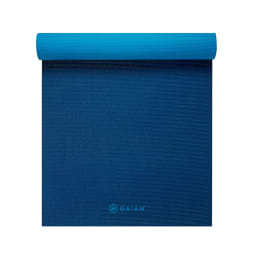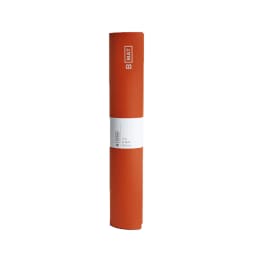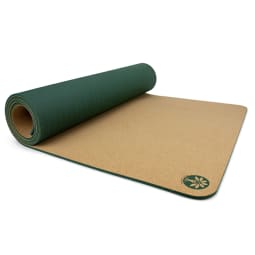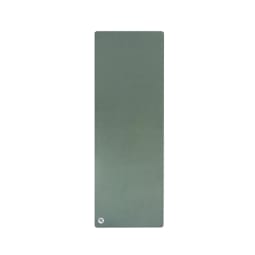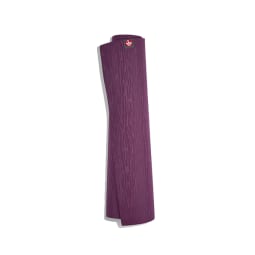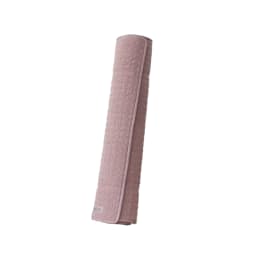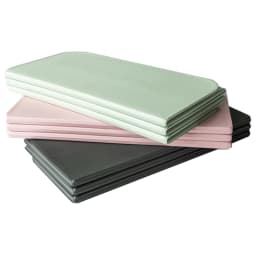Advertisement
The 10 Best Yoga Mats Of 2023, From Super Thick To Extra Grippy


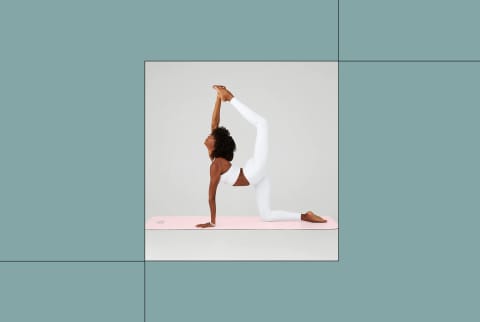
A big part of yoga is setting intention, and a yoga mat can have a surprisingly impactful role when it comes to getting into the right mindset. That colorful roll of vinyl or rubber creates “a defined space where you can feel safe and supported on your fitness journey,” explains Mandy DiMarzo, a yoga practitioner and founder of the BURN online workout.
Roll out your mat, and you really can’t help but feel motivated to start moving. The trick is finding the right yoga mat–and that’s where we come in. Check out our top 10 yoga mat picks for 2023, and get ready to get your om on.
mbg's picks for the best yoga mats of 2023:
How we picked
Durabillity
We looked for mats made of high-quality materials that will withstand the sweatiest workouts, week in and week out.
Thickness
The thickness of a yoga mat makes it more or less suited to specific practices, so we included mats of varying thicknesses to accommodate specific movements.
Ease of cleaning
The best mat is one that’s quickly and easily cleaned, and we prioritized materials designed to make that possible.
Materials
Vinyl and rubber are go-to materials in the yoga world, but we’ve included more earth-friendly options as well.
mbg's picks for the best yoga mats of 2023:
Pros
- Matte finish
- Oversized design
- Dry wicking
Cons
- Pricey
- On the heavy side
Materials:
PolyurethaneLeatherRubberThickness:
5 mmSize(s):
74.4” x 26.4”Alo’s Warrior Mat is everything a good yoga mat should be—firm but cushioning, supple yet grippy. It’s expensive, yes, but you’re investing in a high-quality mat made with premium, ethically-sourced rubber that should last for years to come. It’s slightly oversized, and thanks to its moisture-wicking, anti-odor properties, it’ll stand up to even the sweatiest flow.
Bonus: the Warrior Mat comes in a ton of stylish colors, and that’s an important consideration too. “I believe an important part of choosing a mat is that it has a color that appeals to your heart and makes you feel joy every time you step on it,” says DiMarzo.
Who should try it: Beginners to advanced practitioners, hot yoga enthusiasts
Who should skip it: Shoppers on a budget
What our testers say:
"I've had the Alo Yoga Mat for 3 years and it is still in great shape. It has excellent grip and padding. The only thing to keep in mind is that it is a bit heavy to take on the go." — Angela Onwuka, mbg Senior CRM & Lifecycle Manager
Pros
- Supportive (6 mm thick)
- Reversible
- Great price point
- Wide range of colors
Cons
- Not eco-friendly
Materials:
PVCThickness:
6 mmSize(s):
68” x 26”These reversible yoga mats are easy on the wallet and the joints, thanks to their generous 6mm thickness. They’re textured to help prevent slipping, though some reviewers note that they're not as durable as other options and their colors can scratch off over time with regular use.
Gaiam’s premium mats are made with PVC plastic, so they’re latex-free. This makes them ideal for those with latex allergies. While they aren’t the most eco-friendly pick, they are manufactured without the six most harmful phthalates. Plus, you get four pairs of colors to choose from.
Who should try it: Beginners, budget-conscious shoppers, those with latex allergies
Who should skip it: Consistent practitioners looking for long-term durability
What our testers say:
"I've been using this mat from Gaiam for a couple of years now. I love the designs and size, and they have a good grip."—Courtney Halloran, mbg Director of e-Commerce
Advertisement
Pros
- Supportive (6 mm thick)
- OEKO-TEX certified
- Anti-microbial
Cons
- Pricey
Materials:
RubberThickness:
6 mmSize(s):
71” x 26”Thicker mats offer greater cushioning–something you’ll appreciate if your practice is a high-impact Vinyasa or you just like something substantial beneath you when you’re moving through easier poses. The B Mat Strong 6mm delivers, along with an extra grippy, slightly textured surface, anti-microbial properties, and an OEKO-TEX certification that ensures it’s free of harmful chemicals.
Despite its generous thickness, B Yoga advises against heavy sliding movements on the B Mat. That can create friction that might damage the mat. You’ll want to save this one for yoga practice only.
Who should try it: Anyone with joint pain, those with higher-impact practices
Who should skip it: Those in search of a yoga mat that can be used for other workouts too
Pros
- Travel ready (zipper pouch-purse included)
- Extra lightweight
Cons
- Expensive
- Very thin
Materials:
RubberVegan suedeThickness:
1.5mmSize(s):
72” x 26.7”This travel yoga mat from Sacred is an ultra-lightweight travel mat that doubles as a studio mat topper (germaphobes, this one’s for you). The recyclable mat is made with absorbent vegan suede and natural rubber, so it’s entirely non-toxic and sustainably made. Plus, those materials give it a nice grippy surface and a non-slip bottom.
Since it’s a travel mat, it comes folded in a velvety pouch that doubles as a purse with an adjustable strap and interior pocket.
Who should try it: Those looking for a studio mat topper or a travel-ready mat
Who should skip it: Those looking for deep cushioning
Advertisement
Pros
- Cork gets grippier when wet
- Naturally antimicrobial
- Supportive (6 mm thick)
Cons
- Can’t be rolled tightly, so it's difficult to maneuver
Materials:
Plant-based foamCorkThickness:
6 mmSize(s):
72” x 26”If concerns about slipping as your workout gets sweatier are keeping you from focusing on your posture and breath, it’s time to try a cork mat. This one from Yoloha is soft to the touch, and it gets grippier with moisture. Plus, cork is naturally antimicrobial for a cleaner practice.
This mat is also a good pick if sustainability is top of mind. It’s made with 70% renewable materials. In addition to the natural cork surface, it has a sugarcane-derived plant foam. Together, this blend is cushioning, stable, and ideal if you struggle with sweaty hands. Since cork is a more rigid material that can be tough to roll, this mat is better for an at-home gym setup.
Who should try it: People worried about slipping, eco-conscious shoppers
Who should skip it: Studiogoers who tote their mats to practice
Pros
- Grippy & sticky
- Eco-friendly
- Carry strap included
Cons
- On the thinner side
Materials:
RubberSuedeThickness:
3 mmSize(s):
68” x 24”With its sturdy biodegradable tree rubber base, the Luxe Eco Yoga mat from MoveActive stays where you put it. That means you can maintain proper alignment as you transition from one pose to the next, without worrying about your mat sliding. The top layer is made with a soft-to-the-touch microfiber suede that feels amazing and gets grippier with moisture, making this mat a good pick for hot yoga too.
It comes with a detachable carry strap and it’s free of PVC, latex, and chloride. One drawback is that it’s not reversible.
Who should try it: Hot yoga practitioners, eco-conscious shoppers
Who should skip it: Those looking for more cushioning, people with latex or rubber allergies
Advertisement
Pros
- Reversible
- Antimicrobial
Cons
- Shows sweat marks
- Scratches and scuffs easily
Materials:
PolyurethaneRubberPolyesterNylonThickness:
5 mmSize(s):
71” x 26”It’s hard to put together a list of the best yoga mats without mentioning Lululemon, and this mat in particular stands out for a few reasons. With its reversible design–polyurethane on one side to absorb moisture and maintain grip during sweatier practices and natural rubber on the other side for cushioning support–it’s like two yoga mats in one. That makes it a versatile pick for a wide range of yoga practices.
It’s treated with an antimicrobial additive to help prevent mold and mildew, and both sides wipe down easily with a damp cloth. Reviewers call it cushioning and supportive, but beware that sweat marks do show up pretty clearly (though they fade quickly).
Who should try it: Beginners to advanced practitioners, those looking for a versatile mat for different yoga practices
Who should skip it: Eco-conscious shoppers, those with latex allergies
What our testers say:
"They use Lululmeon mats at one of my workout classes and dang do they hold up well!"—Braelyn Wood, mbg Deputy Commerce Editor
Pros
- Responsibly sourced materials
- Naturally grippy
- Ultra durable
Cons
- Can be slippery during sweaty practices
Materials:
RubberThickness:
5 mmSize(s):
71” x 24” (standard)79” x 24” (long)The eKO mat was developed by yoga teachers over four years, and they really thought of just about everything. It’s made with biodegradable and sustainably harvested tree rubber, along with non-toxic foaming agents for a truly eco-friendly finished product. The natural rubber makes it incredibly durable, while a proprietary surface texture gives the mat an impressively long lifespan and naturally grippy surface for dry traction.
A closed-cell surface design keeps sweat from seeping into the mat. That means fast, easy clean-up after a yoga session, but it can make things a little slippery if you get extra sweaty. If that’s the case, you’ll want to keep a towel handy.
Who should try it: Eco-conscious shoppers
Who should skip it: Hot yoga enthusiasts
What our testers say:
"This is the only yoga mat I've used at home for years, and it works just as well for yoga flows as it does HIIT training. It's the perfect thickness, in my opinion: it lends enough support but is also really easy to fold up and travel with. I could be better about cleaning my mat, but it's pretty forgiving about showing stains. The responsibly sourced materials and soothing colorways are an added bonus." — Emma Loewe, mbg Sustainability + Health Director
Advertisement
Pros
- Highly absorbent for sweaty flows
- Machine washable
Cons
- Not reversible
- May be a little slippery
- Expensive
Materials:
Organic cottonNatural latexThickness:
5 mmSize(s):
71” x 24”This organic yoga mat from Brentwood Home is GOTS certified and made with cotton and a non-slip natural latex base. The fabric is soft, textured for grip, and naturally absorbent to wick away moisture. The anti-skid bottom gives it stability, and the mat as a whole is soft and cushioning for forearm and kneeling poses.
Brentwood Home describes it as a yoga mat and a towel, which makes it ideal for hot, active, or sweaty practices. After class, the mat can be aired out and rolled up. Even better, it can be machine washed for easy clean up. If you’re not sure about this one, good news: Brentwood offers a 30-day trial window.
Who should try it: Eco-conscious shoppers, travelers
Who should skip it: Those looking for a traditional feel or a mat that can be wiped down
Pros
- Adaptable & stackable
- Supportive (10 mm thick)
Cons
- May be too thick for some yoga practices
Materials:
EVA foamThickness:
10 mmSize(s):
69” x 23.6”Sick of folding the end of your yoga mat in for a little extra cushion? So were the founders of Stakt. This patent-pending mat is twice as thick as a traditional yoga mat, with a foldable design that makes it super versatile. It can be folded all the way from mat length into a block you can use as a meditation seat or for exercises like planks, push-ups, lunges, and more.
Stakt is double-sided–one side is smooth, and the other is a little grippier to keep you from sliding around. It wipes down easily with warm water and oil-free soap.
Who should try it: Those looking for a versatile mat to accommodate a range of workouts
Who should skip it: Those looking to stay grounded during balance poses
Advertisement
Choosing the right mat for you.
The right yoga mat for you is the one that will support your practice and preferences. Here’s what to keep in mind.
Size & thickness
“The most important thing about choosing a new mat is that it’s thick enough to withstand the work you will be doing on it,” says DiMarzo.
Your practice will dictate the most appropriate thickness. Too thin and your mat won't be supportive enough. Too thick, however, and you may lose the grounding connection to the earth. Even an extra millimeter can make a big difference. Emily Burkhardt, a yoga and Pilates instructor in Australia, says that a mat between three and five millimeters will be suitable for most practices. This size range will allow for a bit of cushioning and still roll up easily for storage and portability.
Taller practitioners will benefit from using an oversized mat, longer than a 70 inches.
Grip & stickiness
A grippy mat gives you a stable base–all the better to focus on your practice. Stickiness, meanwhile, keeps your mat in place, so it isn’t sliding around. Both are important for maintaining alignment. Some mats get grippier with moisture; something to consider if you get sweaty. A general rule of thumb–the more texture a mat has, the better the grip.
Materials & sustainability
The material of your yoga mat affects other considerations, like its texture, cushioning, grip, stickiness, eco-friendliness, and durability. Standard yoga mats are made with PVC platstic—which is tricky to recycle and won’t break down in a landfill.
Eco-conscious shoppers can opt for mats made with more natural materials, including natural and recycled rubber, cork, or jute.
Ease of cleaning
Yoga mats get dirty, and it’s important to clean them regularly. Manufacturers will have specific directions for their mats, but if you want to keep this as simple as possible, smoother mats are generally easier to clean and dry quickly so they can be rolled up again.
Price point & durability
Basic mats made with PVC will be more budget-friendly, and prices tick upward for upgrades like antimicrobial treatments, sustainable materials, texture, prints, and designs.
“People need to keep longevity in mind,” advises Brittany Noble, a certified yoga instructor at YogaPod. “You can purchase off-brand mats at many different retailers that will only last a handful of times before peeling and falling apart. Chances are if you invest in a decent mat, you’re more likely to continue your practice.
Frequently Asked Questions
Which brand yoga mat is best?
Everyone has an opinion on the best yoga mat brand, and there are plenty of great options on the market. Manduka, Gaiam, and Lululemon are a few that yoga teachers consistently rank as their favorites.
What thickness mat is best for yoga?
The standard yoga mat is ⅛ inch thick, but they can vary from 1/16 of an inch (for travel mats) up to about ¼ inch. The trick is finding a mat that’s thick enough to be comfortable for kneeling posts or lunges, but not so thick that you no longer feel grounded into the floor. Burkhardt advises a mat between 3 and 5 millimeters, which is roughly ⅛ of an inch.
What’s the best yoga mat for beginners?
Beginners will do well with a grippy yoga mat of standard thickness. There’s no need to overthink it, but don’t assume the cheapest, most basic option is all you need. “Just because you are a beginner doesn't mean you have to buy a cheap mat over one that feels a little too ‘advanced’ for you,” says DiMarzo. “Buy a mat you will grow into and it will grow with you.”
The takeaway.
Your yoga mat is a space for you to breathe, push, and grow, so it’s worth a little thought and consideration to find one that will support you in your practice. The 10 options on this list all come highly rated and recommended. New to yoga? Check out our beginner’s guide and basic postures to help you get started on your new mat.

